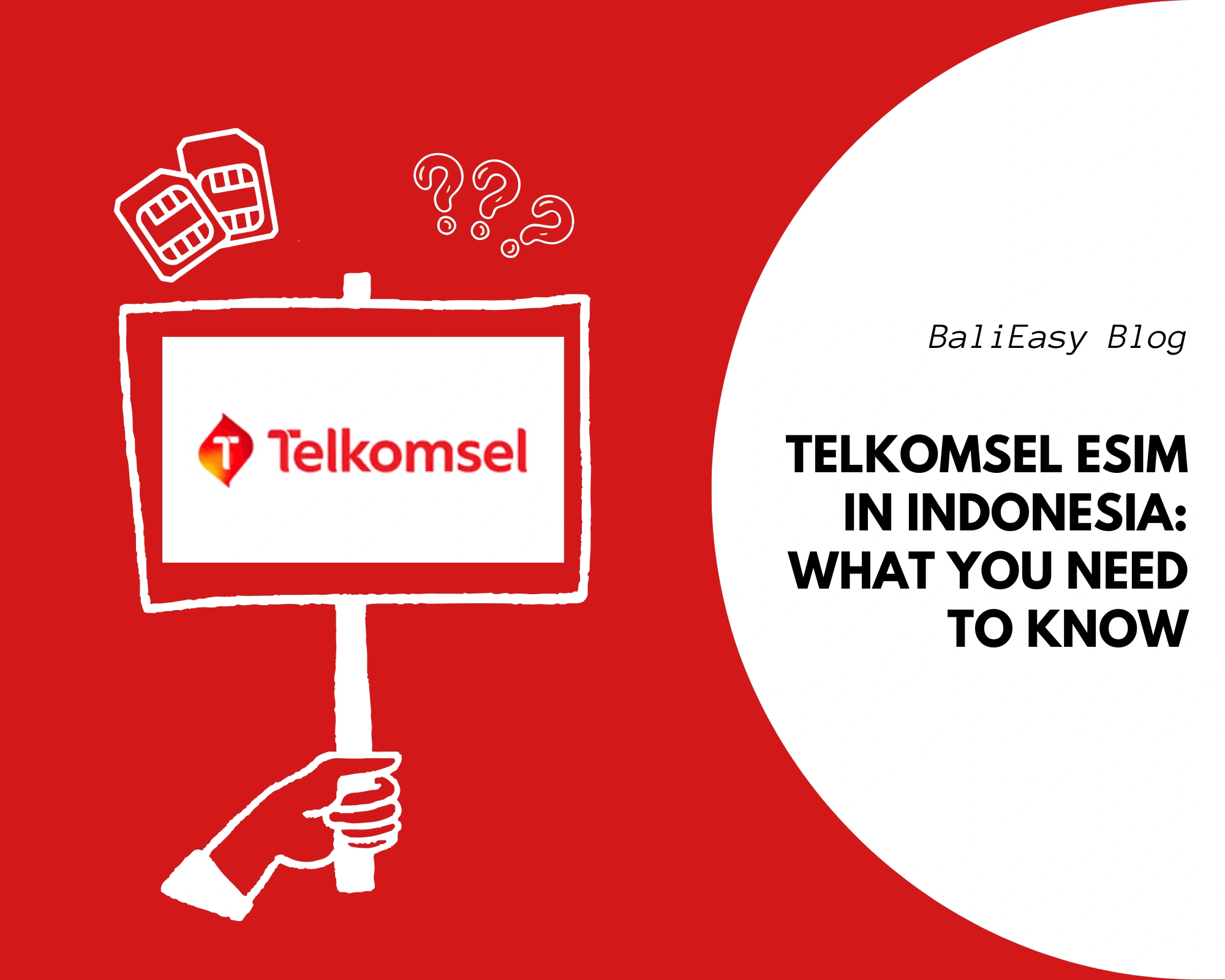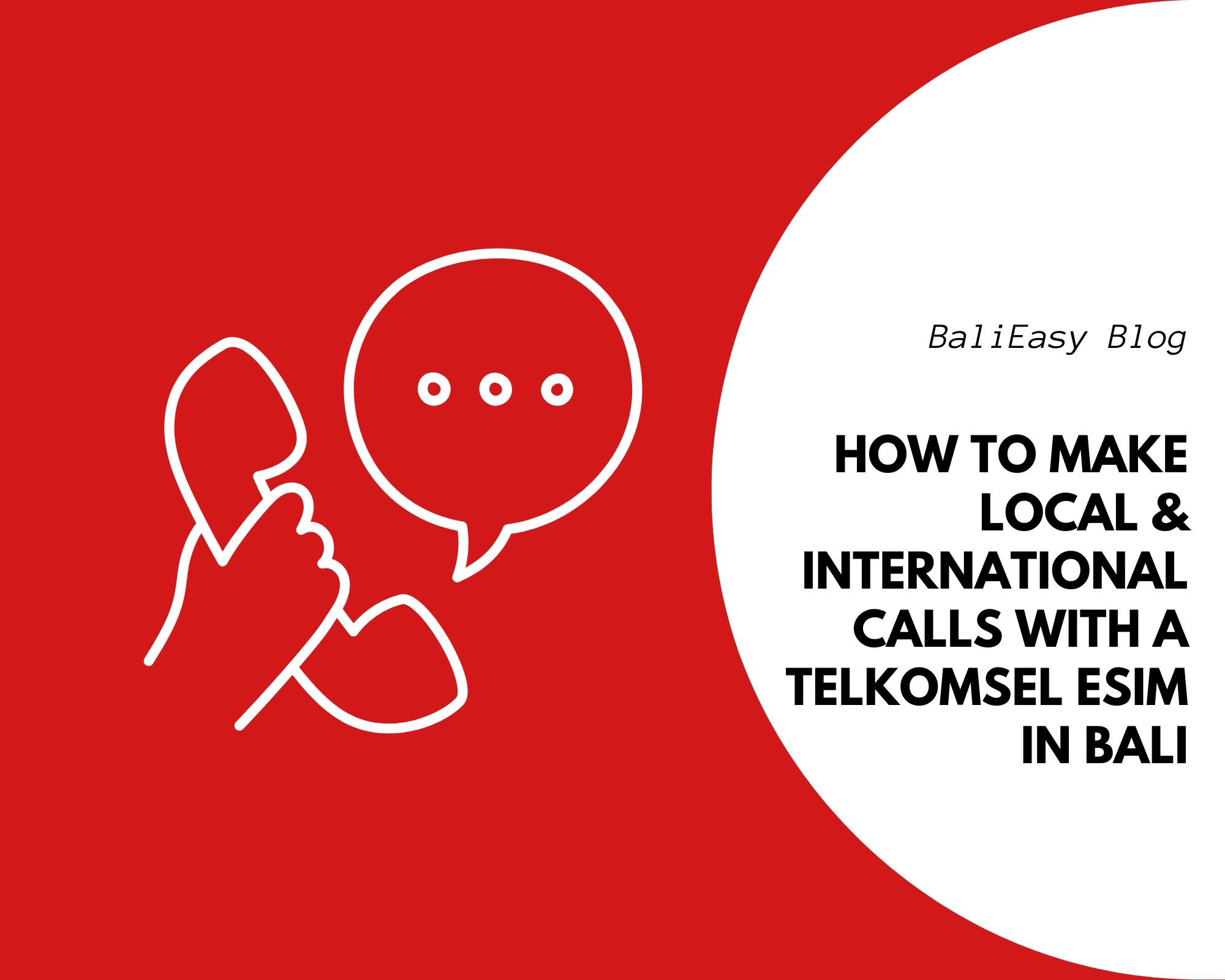
Telkomsel eSIM in Indonesia: What You Need to Know
Telkomsel is Indonesia’s leading mobile network provider, known for its wide coverage, stable connection, and fast 4G/5G speeds. This guide

Staying connected in Bali is essential for navigation, ride-hailing, or sharing your adventures on social media. Fortunately, Bali has several mobile network options for tourists.
In this guide, we’ll compare the major providers – Telkomsel, XL Axiata, Indosat Ooredoo (IM3), and Tri, plus Smartfren – in terms of coverage, speed, and reliability.
We’ll also break down eSIM vs. physical SIM cards and recommend the best choices for different travelers (from short-term visitors to digital nomads and business travelers).
Finally, we’ll highlight a convenient eSIM solution as a top pick for hassle-free connectivity.
Bali is well-covered by Indonesia’s big three mobile operators (Telkomsel, XL, Indosat) and a couple of smaller players. Here’s how they stack up:

Telkomsel is Indonesia’s largest provider and the go-to choice for the best coverage. It reaches 98% of Indonesia’s population, which translates to near blanket coverage across Bali.
Even in rural villages, mountain regions, or smaller islands around Bali, Telkomsel usually has a signal . This makes it ideal if you plan to explore beyond the tourist hotspots – from Ubud’s rice terraces to remote beaches, Telkomsel keeps you connected when other networks might drop out.
It also offers fast data speeds (including the first 5G service in Bali, though 5G coverage is still very limited to areas around Denpasar, Kuta and Nusa Dua).
The trade-off is price: Telkomsel’s plans tend to be a bit more expensive than others. However, many travelers feel the reliability and island-wide coverage justify the cost. If you don’t want to worry about signal at all during your trip – especially in off-the-beaten-path places – Telkomsel is the top pick.
XL Axiata is another major provider with strong performance, especially in Bali’s populated areas.
XL offers good 4G coverage in urban and tourist hotspots like Kuta, Seminyak, Canggu, and Ubud. Many tourists favor XL for its combination of reliable signal in these areas and affordable data packages.
In terms of internet speeds, XL’s 4G is competitive and generally fast in the south Bali tourist belt (often on par with Telkomsel in city areas) . Where XL falls short is in remote coverage – it doesn’t reach as deep into rural corners. For example, coverage in places like the outskirts of Ubud or up in the mountains can be inconsistent on XL compared to Telkomsel’s signal.
The company is improving its network, but as of now Telkomsel still has the edge in Bali’s remotest spots. If you’re mostly sticking to the main tourist zones, XL is a great value choice that balances good performance with lower cost. (XL also offers eSIM plans for convenience, which we’ll discuss later.)
Indosat Ooredoo – commonly marketed as IM3 – is known for competitive pricing and generous data allowances, making it attractive to budget-conscious travelers.
In Bali, Indosat provides decent 4G coverage in cities and popular tourist spots (Denpasar, Kuta, Seminyak, Ubud town, etc.). If you plan to stay within these urban areas, you’ll find the service adequate for browsing, maps, and social media.
However, Indosat’s coverage is not as extensive as Telkomsel’s or XL’s – venture into more rural parts of Bali and you may find a weak signal or dead zones on Indosat. Notably, Indosat (Ooredoo) merged with 3 (Tri) Indonesia, another provider known for very cheap data plans but with even more limited coverage.
Tri SIM cards (still sold separately in some places) offer excellent value – huge data for low cost – but only work well in town centers and densely populated areas.
In practical terms, Indosat/Tri is best for short stays in South Bali or if you have access to Wi-Fi for backup, since you get a lot of data for your money, as long as you don’t need coverage in the remote corners. It’s a solid budget option for basic connectivity in the main areas.
Smartfren is a smaller operator that can be a hidden gem for data-hungry users, with affordable packages (including unlimited or high-volume data plans).
Smartfren runs a 4G/LTE-only network and even offers tourist eSIMs and SIM cards with large data bundles (e.g. 30–60 GB packages).
In major tourist areas, Smartfren’s 4G signal is generally available and speeds are solid . The catch is coverage: because Smartfren has no 3G or 2G fallback, its signal disappears in areas where 4G is weak.
This means Smartfren’s coverage is the narrowest of the bunch – essentially fine in South Bali and cities, but very spotty or non-existent in rural villages, mountains, or less developed parts of the island. If you plan to stay in places like Canggu, Seminyak, or Denpasar and you need a lot of data at low cost, Smartfren could be worth considering.
Just be aware that if you head to a remote beach or up to Tegalalang in Ubud, you might lose signal entirely on Smartfren. In short, great data deals, limited coverage.
Bali’s tourist destinations each have slightly different connectivity experiences. Here’s a quick area-by-area rundown so you know what to expect:
Ubud (Central Bali)
Ubud town is generally well covered by the “big three” (Telkomsel, XL, Indosat) , so in the central area you can use any of them for Google Maps, WhatsApp, Instagram, etc. However, Ubud’s charm lies in its outskirts (rice paddies, waterfalls, retreats), and once you venture away from the town center, Telkomsel shines.
It has the strongest signal penetrating into Ubud’s rural surroundings. XL and Indosat work in Ubud, but their coverage can get patchy in the outskirts or deep in the Monkey Forest area, where Telkomsel still often manages at least a 3G/4G signal.
If Ubud is your base and you need dependable data for navigating small roads or uploading content from a jungle villa, Telkomsel is the safest bet. XL or Indosat will suffice if you’ll mostly be in town or at cafés with Wi-Fi, but expect occasional dead spots on those networks once you’re in the countryside.
Seminyak & Canggu (Southwest Bali)
These popular areas are in Bali’s well-developed south, so all major providers have good coverage here. You’ll find strong 4G LTE signal in Seminyak’s shopping streets and along Canggu’s beach clubs whether you use Telkomsel, XL, or Indosat.
Even Smartfren has 4G signal in Seminyak/Canggu since these are high-traffic zones. In terms of performance, Telkomsel and XL tend to offer the fastest and most consistent data speeds in these areas, especially during peak hours when networks get congested.
Indosat will handle normal usage fine (browsing Instagram, WhatsApp, etc.), but if you’re doing something bandwidth-heavy like video calls or streaming in 4K, you might notice Telkomsel/XL hold up better during the busy evenings.
Overall, in Seminyak and Canggu you won’t go wrong with any of the big providers – connectivity in these towns is generally strong and stable.
Nusa Dua (Southeast Bali)
Nusa Dua is a resort enclave with excellent infrastructure. Telkomsel, XL, and Indosat all have reliable coverage in Nusa Dua, and you should get a steady 4G connection throughout the area (hotels, conference centers, beaches).
Notably, Telkomsel has even rolled out some 5G coverage in Nusa Dua (as well as parts of nearby Kuta and Denpasar). 5G is still very limited in Bali, but if you have a 5G-capable phone and a Telkomsel SIM, you might catch a super-fast signal in Nusa Dua’s vicinity.
For practical purposes, 4G from any provider will be sufficient here. If you’re a business traveler attending an event at the Nusa Dua convention center, for instance, Telkomsel could offer a slight edge in speed (and that nascent 5G) to ensure flawless video meetings, but XL and Indosat will also serve you well in this area’s well-covered terrain.
Uluwatu (South Bali, Bukit Peninsula)
Uluwatu’s cliffside temples and surf beaches are a bit more removed from the urban centers. Telkomsel once again tends to be the most reliable choice in Uluwatu, as it has towers covering the Bukit Peninsula where Uluwatu is located.
In practical terms, around the famous Uluwatu Temple, the beach clubs, and the main roads, you will get signal on XL and Indosat too – these companies know Uluwatu is a popular spot now. But if you explore smaller roads or stay at a cliffside villa, you might find XL or Indosat’s signal weaker or dropping to 3G, whereas Telkomsel often maintains better coverage in these fringe areas.
Smartfren is hit-or-miss here; it may work near the main tourist sites, but don’t expect coverage down every winding road (remember, no 3G fallback). For surfers heading to hidden breaks or anyone staying in the more isolated parts of the Bukit, Telkomsel will give you the best chance of staying connected.
For general tourist visits (sunset at Single Fin bar, etc.), any major SIM should do the job in Uluwatu, with Telkomsel just offering a bit more peace of mind.
Bottom line
Bali’s south (airport area, Kuta-Seminyak-Canggu, Nusa Dua, Jimbaran) enjoys strong coverage from all providers. As you go north or inland (Ubud, Sidemen, Lovina) or to outlying islands, Telkomsel becomes increasingly advantageous because of its far-reaching network.
If your itinerary is mostly the main tourist areas, you can comfortably choose based on budget and data needs. If it includes remote adventures, lean towards Telkomsel for coverage insurance.
Want to make calls or receive OTPs using an eSIM? Here’s how to use Telkomsel eSIM for calls and SMS in Bali
Bali offers a range of mobile connectivity options, and the “best” network really depends on your plans. If you want the absolute widest coverage and don’t mind paying a bit more, Telkomsel will have you covered from the surf breaks of Uluwatu to the lakes of north Bali.
If you’re primarily in the tourist hubs, providers like XL or Indosat can save you money while still keeping you online. Tech-savvy travelers are increasingly turning to eSIMs for their flexibility and convenience, avoiding the need to swap physical cards on short trips.
Ready to connect in seconds? Consider using BaliEasy eSIM for your trip. BaliEasy is a convenient eSIM service tailored for inbound tourists – you purchase it online and activate it with a QR code, so your phone connects to a top local network as soon as you arrive.
You can also set up your eSIM before traveling to Bali, so your data works the moment your plane lands. Activation is quick and simple, most users can go online within minutes. If you’re wondering how long it takes, here’s a guide on eSIM activation time in Bali.
No more hunting for a SIM card vendor or dealing with registration forms after a long flight. With BaliEasy, you get the reliability of Bali’s major networks with the simplicity of a digital setup. It’s an excellent choice if you value a hassle-free experience or are arriving at odd hours when shops might be closed.
Simply put, BaliEasy lets you hit the ground running – you can order a ride, check your villa’s location, and send an “I arrived!” message the moment you land.
Stay connected, travel smarter, and enjoy Bali without missing a beat online. Whether you choose a local SIM or a handy eSIM like BaliEasy, a little preparation will ensure you have fast, reliable internet throughout your Bali adventure.
Happy travels and enjoy the Island of the Gods with full bars and full confidence in your mobile network!

Telkomsel is Indonesia’s leading mobile network provider, known for its wide coverage, stable connection, and fast 4G/5G speeds. This guide

Landed in Bali and need to call your driver, confirm your villa, or check in with family abroad? With a
Discount Applied Successfully!
Your savings have been added to the cart.
WhatsApp us
📌 How It Works: